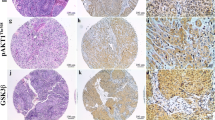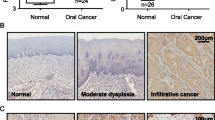Abstract
ATG9A is an integral membrane protein required for autophagosome formation and a membrane carrier in the autophagy pathways. The present study was designed to investigate the expression of ATG9A in oral squamous cell carcinoma (OSCC). Clinically annotated tumor specimens from 90 patients with OSCC were subjected to immunohistochemistry using an antibody against ATG9A and immunoreactivity was scored using an immunoreactivity score (IRS). Scores were compared with clinical and pathologic data to assess association with outcome. Overexpression of ATG9A was defined as an IRS of ≥9 by receiver operating characteristics curve analysis and was identified in 25 (28 %) of 90 cases. ATG9A overexpression was associated with disease recurrence and overall survival (OS) in both univariate (p = 0.030 and 0.025, respectively) and multivariate (p = 0.026 and 0.038, respectively) Cox analyses. Kaplan–Meier plots also showed that patients with ATG9A overexpression had shorter 3-year OS (p = 0.017) and time to recurrence (p = 0.021) than those with low ATG9A expression. These results suggest that the presence of ATG9A in the cytoplasm of tumor cells may be an independent biomarker for disease recurrence and survival in patients with OSCC.


Similar content being viewed by others
References
Landis SH, Murray T, Bolden S, Wingo PA (1999) Cancer statistics, 1999. CA Cancer J Clin 49(8–31):31
Parkin DM, Bray F, Ferlay J, Pisani P (2005) Global cancer statistics, 2002. CA Cancer J Clin 55:74–108
Marino G, Lopez-Otin C (2004) Autophagy: molecular mechanisms, physiological functions and relevance in human pathology. Cellular and molecular life sciences : CMLS 61:1439–1454
Levine B, Klionsky DJ (2004) Development by self-digestion: molecular mechanisms and biological functions of autophagy. Dev Cell 6:463–477
Mizushima N (2007) Autophagy: process and function. Gene Dev 21:2861–2873
Suzuki K, Kirisako T, Kamada Y, Mizushima N, Noda T, Ohsumi Y (2001) The pre-autophagosomal structure organized by concerted functions of APG genes is essential for autophagosome formation. EMBO J 20:5971–5981
Krick R, Muehe Y, Prick T, Bremer S, Schlotterhose P, Eskelinen EL, Millen J, Goldfarb DS, Thumm M (2008) Piecemeal microautophagy of the nucleus requires the core macroautophagy genes. Mol Biol Cell 19:4492–4505
Sekito T, Kawamata T, Ichikawa R, Suzuki K, Ohsumi Y (2009) Atg17 recruits Atg9 to organize the pre-autophagosomal structure. Gene Cell: Devoted Mol Cell Mech 14:525–538
Young AR, Chan EY, Hu XW, Kochl R, Crawshaw SG, High S, Hailey DW, Lippincott-Schwartz J, Tooze SA (2006) Starvation and ULK1-dependent cycling of mammalian Atg9 between the TGN and endosomes. J Cell Sci 119:3888–3900
Yamada T, Carson AR, Caniggia I, Umebayashi K, Yoshimori T, Nakabayashi K, Scherer SW (2005) Endothelial nitric-oxide synthase antisense (NOS3AS) gene encodes an autophagy-related protein (APG9-like2) highly expressed in trophoblast. J Biol Chem 280:18283–18290
Yang ZJ, Chee CE, Huang S, Sinicrope FA (2011) The role of autophagy in cancer: therapeutic implications. Mol Canc Therapeut 10:1533–1541
Degenhardt K, Mathew R, Beaudoin B, Bray K, Anderson D, Chen G, Mukherjee C, Shi Y, Gelinas C, Fan Y, Nelson DA, Jin S, White E (2006) Autophagy promotes tumor cell survival and restricts necrosis, inflammation, and tumorigenesis. Canc Cell 10:51–64
Gozuacik D, Kimchi A (2004) Autophagy as a cell death and tumor suppressor mechanism. Oncogene 23:2891–2906
Mathew R, Karantza-Wadsworth V, White E (2007) Role of autophagy in cancer. Nature reviews. Cancer 7:961–967
Kimmelman AC (2011) The dynamic nature of autophagy in cancer. Gene Dev 25:1999–2010
Webber JL, Young AR, Tooze SA (2007) Atg9 trafficking in mammalian cells. Autophagy 3:54–56
White E, DiPaola RS (2009) The double-edged sword of autophagy modulation in cancer. Clin Cancer Res: Off J Am Assoc Cancer Res 15:5308–5316
Katayama M, Kawaguchi T, Berger MS, Pieper RO (2007) DNA damaging agent-induced autophagy produces a cytoprotective adenosine triphosphate surge in malignant glioma cells. Cell Death Differ 14:548–558
Carew JS, Nawrocki ST, Kahue CN, Zhang H, Yang C, Chung L, Houghton JA, Huang P, Giles FJ, Cleveland JL (2007) Targeting autophagy augments the anticancer activity of the histone deacetylase inhibitor SAHA to overcome Bcr-Abl-mediated drug resistance. Blood 110:313–322
Amaravadi RK, Yu D, Lum JJ, Bui T, Christophorou MA, Evan GI, Thomas-Tikhonenko A, Thompson CB (2007) Autophagy inhibition enhances therapy-induced apoptosis in a Myc-induced model of lymphoma. J Clin Investig 117:326–336
Li X, Fan Z (2010) The epidermal growth factor receptor antibody cetuximab induces autophagy in cancer cells by downregulating HIF-1alpha and Bcl-2 and activating the beclin 1/hVps34 complex. Canc Res 70:5942–5952
Han J, Hou W, Goldstein LA, Lu C, Stolz DB, Yin XM, Rabinowich H (2008) Involvement of protective autophagy in TRAIL resistance of apoptosis-defective tumor cells. J Biol Chem 283:19665–19677
Conflict of interest
We declare that we have no conflict of interest.
Author information
Authors and Affiliations
Corresponding authors
Rights and permissions
About this article
Cite this article
Tang, JY., Hsi, E., Huang, YC. et al. ATG9A overexpression is associated with disease recurrence and poor survival in patients with oral squamous cell carcinoma. Virchows Arch 463, 737–742 (2013). https://doi.org/10.1007/s00428-013-1482-5
Received:
Revised:
Accepted:
Published:
Issue Date:
DOI: https://doi.org/10.1007/s00428-013-1482-5




